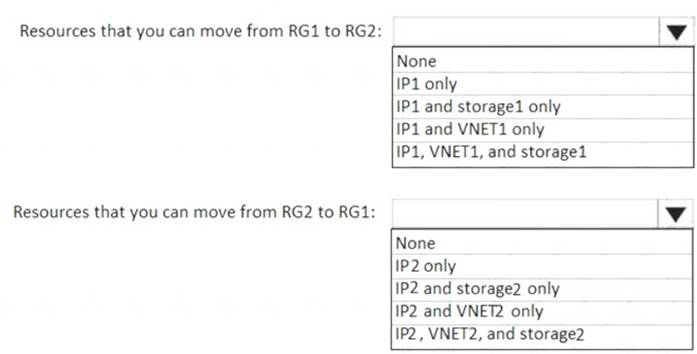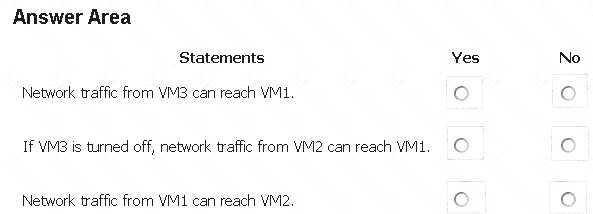- (Exam Topic 4)
Note: This question is part of a series of questions that present the same scenario. Each question in the series contains a unique solution that might meet the stated goals. Some question sets might have more than one correct solution, while others might not have a correct solution.
After you answer a question in this section, you will NOT be able to return to it. As a result, these questions will not appear in the review screen.
You have an Azure subscription named Subscription1 that contains the resources shown in the following table.
VM1 connects to a virtual network named VNET2 by using a network interface named NIC1. You need to create a new network interface named NIC2 for VM1.
Solution: You create NIC2 in RG2 and West US. Does this meet the goal?
Correct Answer:
A
The virtual machine you attach a network interface to and the virtual network you connect it to must exist in the same location, here West US, also referred to as a region.
References:
https://docs.microsoft.com/en-us/azure/virtual-network/virtual-network-network-interface
- (Exam Topic 6)
VM1 is running and connects to NIC1 and Disk1. NIC1 connects to VNET1.
RG2 contains a public IP address named IP2 that is in the East US location. IP2 is not assigned to a virtual machine.
For each of the following statements, select Yes if the statement is true. Otherwise, select No.
NOTE: Each correct selection is worth one point.
Solution:
Reference:
https://docs.microsoft.com/en-us/azure/azure-resource-manager/management/move-support-resources https://docs.microsoft.com/en-us/azure/virtual-network/move-across-regions-publicip-powershell
Does this meet the goal?
Correct Answer:
A
- (Exam Topic 5)
You plan to deploy three Azure virtual machines named VM1, VM2, and VM3. The virtual machines will host a web app named App1.
You need to ensure that at least two virtual machines are available if a single Azure datacenter becomes unavailable.
What should you deploy?
Correct Answer:
C
https://docs.microsoft.com/de-de/azure/virtual-machines/windows/tutorial-availability-sets
Each zone is made up of one or more datacenters equipped with independent power, cooling, and networking. To ensure resiliency, there are a minimum of three separate zones in all enabled regions.
- (Exam Topic 4)
You have an Azure subscription that contains the resource groups shown in the following table.
RG1 contains the resources shown in the following table.
RG2 contains the resources shown in the following table.
You need to identify which resources you can move from RG1 to RG2, and which resources you can move
from RG2 to RG1.
Which resources should you identify? To answer, select the appropriate options in the answer area.
Solution:
Read only and Delete lock won't prevent you from moving resources in different resource groups. It will prevent you to do the operations in the resource group where the resources are there.
So the correct answer should be
RG1 --> RG2 = IP1, vnet1 and storage1 RG2 --> RG1 = IP2, vnet2 and storage2 Reference:
https://docs.microsoft.com/en-us/azure/governance/blueprints/concepts/resource-locking
Does this meet the goal?
Correct Answer:
A
- (Exam Topic 5)
You have an Azure subscription named Subscription1. Subscription1 contains the virtual machines in the following table.
Subscription1 contains a virtual network named VNet1 that has the subnets in the following table.
VM3 has a network adapter named NIC3. IP forwarding is enabled on NIC3. Routing is enabled on VM3. You create a route table named RT1. RT1 is associated to Subnet1 and Subnet2 and contains the routes in the following table.
You apply RT1 to Subnet1.
For each of the following statements, select Yes if the statement is true. Otherwise, select No. NOTE: Each correct selection is worth one point.
Solution:
Box 1: Yes
Traffic from VM1 and VM2 can reach VM3 thanks to the routing table, and as IP forwarding is enabled on VM3, traffic from VM3 can reach VM1.
Box 2: No
VM3, which has IP forwarding, must be turned on, in order for traffic from VM2 to reach VM1. Box 3: Yes
The traffic from VM1 will reach VM3, which thanks to IP forwarding, will send the traffic to VM2. Reference:
https://docs.microsoft.com/en-us/azure/virtual-network/virtual-networks-udr-overview
Does this meet the goal?
Correct Answer:
A